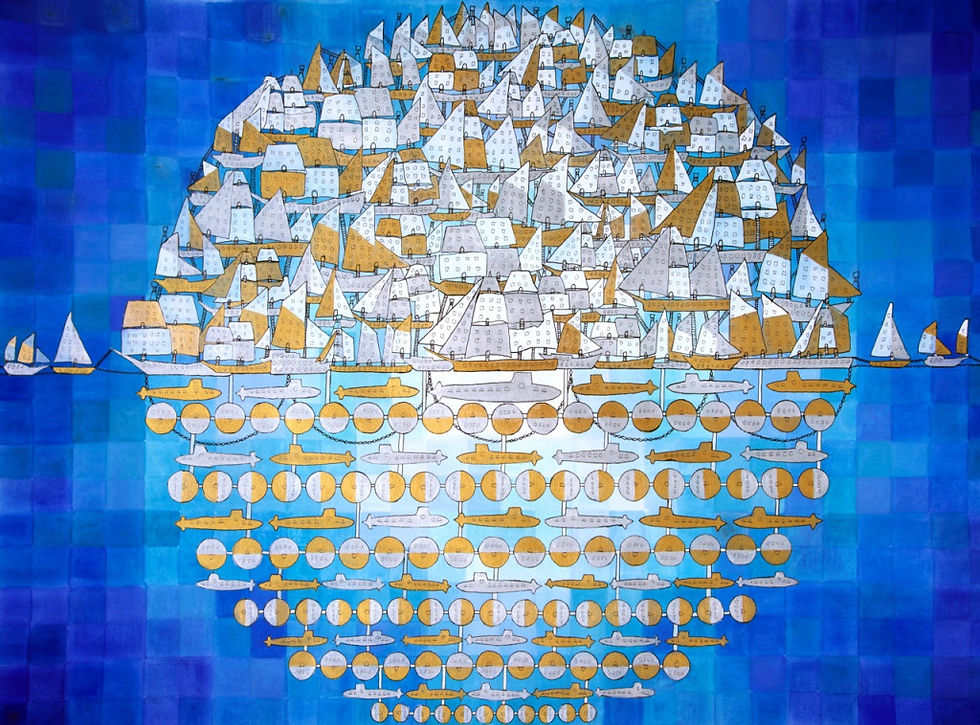Armada
- Paul Dobraszczyk
- Aug 22, 2016
- 3 min read
Updated: Aug 4, 2020

Paul Dobraszczyk, ‘Armada’, 2016, ink, chalk, watercolour, gouache, and pen on paper. Inspired by China Miéville’s novel The Scar (2002).
China Miéville’s 2002 novel The Scar, the second book in his extraordinary Bas-Lag trilogy, presents a characteristic fantastical world that is rendered in exquisite detail. Borrowing from Lloyd’s Kropp’s earlier book The Drift (1969), which was set on an inhabited agglomeration of decaying ships in the Sargasso Sea, Mieville’s novel focuses on the floating pirate city of Armada. In contrast to the contemplative stillness of The Drift, Armada is a super-dense, bustling floating and mobile metropolis of hundreds of thousands of inhabitants, with most of the hundreds of ships tethered together with chains and bridges long since built over with ‘tall brickwork, steeples, masts and chimneys and ancient rigging’. The underside of the city is no less vibrant – ‘wire-mesh cages tucked into hollows and dangling from chains, crowded with fair cod and tunny’ were harvested by the Cray, a hybrid race of half-human half-crayfish who live underwater in coral-like dwellings attached to the ships’ hulls. Grounded in its marine context both above and below, ‘a moving ecology and politics were tethered to the city’s calcified base’ while the buildings above the water were all ‘licked by constant damp, contoured with salt – steeped in the sounds of waves and the fresh-rot smell of the sea.’

Sketch for ‘Armada’, 2016. Watercolour, gouache and ink on paper.
Taken by force whilst sailing into exile from Miéville’s other invented city New Crobuzon, the central protagonist, academic Bellis Coldwine, becomes part of an alternative society made possible by piracy, whether stealing ships to add to the city’s fabric or people to its population. And unlike Kropp’s city, Armada moves – initially very slowly, pulled across the endless oceans by dozens of tug boats, but later much faster under the steam of a gargantuan sea creature – the avanc – that the city authorities successfully tethers. The architecture of Armada is imagined as chaotically hybrid. On the one hand, this is evident in a material sense, where ‘countless naval architectures. Stripped longships; scorpion-galleys; luggers and brigantines; massive steamers hundreds of feet long down to canoes no lager than a man’ have been reclaimed ‘from the inside out’, with ‘structures, styles and materials shoved together from a hundred histories and aesthetics into a compound architecture’. On the other, such hybridity also extends to the social life of the city. Although ‘ruled by cruel mercantilism, existing in the pores of the world [and] snatching new citizens from their ships’, Armada’s social codes are also fiercely egalitarian – the former Remade slaves now freed and equal to any other citizens – and democratic: like The Drift, Armada is divided up into discrete kingdoms, each controlled by powerful leaders but each with their own distinct social customs. Although one of these kingdoms – Garwater – gains control of the fate of the entire city, this power is never safe from democratic challenge, as demonstrated in the mutiny that occurs in the latter stages of the novel.

Floating city sketch, 2016. Chalk, watercolour, gouache and ink on paper.
What Miéville’s imagined floating city does so well is to provide a vivid and sustained sense of the material, mental and social life of a such a city. A fantastical creation it may be, but in fleshing it out over the course of nearly 700 pages, Mieville provides a far more convincing picture of what might mean to live in such a city than any of the 3D renderings and other images produced by architects that have proposed floating urban communities, particularly those submitted in response to a 2015 competition launched by the Seasteading Institute. Perhaps more significantly, Miéville’s Armada also reimagines the possibilities of social life in such a city as much as its urban fabric; by doing so, he stretches our imaginations to think in a broad and open way about the richness and complexity of the relationship between speculative design and social life.



Comments